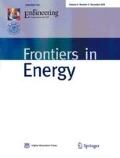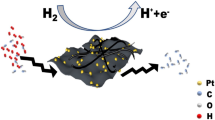Abstract
Fuel starvation can occur and cause damage to the cell when proton exchange membrane fuel cells operate under complex working conditions. In this case, carbon corrosion occurs. Oxygen evolution reaction (OER) catalysts can alleviate carbon corrosion by introducing water electrolysis at a lower potential at the anode in fuel shortage. The mixture of hydrogen oxidation reaction (HOR) and unsupported OER catalyst not only reduces the electrolysis efficiency, but also influences the initial performance of the fuel cell. Herein, Ti4O7 supported IrOx is synthesized by utilizing the surfactant-assistant method and serves as reversal tolerant components in the anode. When the cell reverse time is less than 100 min, the cell voltage of the MEA added with IrOx/Ti4O7 has almost no attenuation. Besides, the MEA has a longer reversal time (530 min) than IrOx (75 min), showing an excellent reversal tolerance. The results of electron microscopy spectroscopy show that IrOx particles have a good dispersity on the surface of Ti4O7 and IrOx/Ti4O7 particles are uniformly dispersed on the anode catalytic layer. After the stability test, the Ti4O7 support has little decay, demonstrating a high electrochemical stability. IrOx/Ti4O7 with a high dispersity has a great potential to the application on the reversal tolerance anode of the fuel cell.
Similar content being viewed by others
References
Hong B K, Mandal P, Oh J G, et al. On the impact of water activity on reversal tolerant fuel cell anode performance and durability. Journal of Power Sources, 2016, 328: 280–288
Polagani R K, Suryawanshi P L, Gumfekar S P, et al. Ultrasound-assisted synthesis of Pt-Co/C bimetallic alloys for oxygen reduction in PEM fuel cells. Sustainable Energy & Fuels, 2018, 2(7): 1491–1499
Debe M K. Electrocatalyst approaches and challenges for automotive fuel cells. Nature, 2012, 486(7401): 43–51
Jang J, Sharma M, Choi D, et al. Boosting fuel cell durability under shut-down/start-up conditions using a hydrogen oxidation-selective metal-carbon hybrid core-shell catalyst. ACS Applied Materials & Interfaces, 2019, 11(31): 27735–27742
Huang Z, Shen J, Chan S H, et al. Transient response of performance in a proton exchange membrane fuel cell under dynamic loading. Energy Conversion and Management, 2020, 226: 113492
Zhou X, Ji H, Li B, et al. High-repetitive reversal tolerant performance of proton-exchange membrane fuel cell by designing a suitable anode. ACS Omega, 2020, 5(17): 10099–10105
Shen J, Xu L, Chang H, et al. Partial flooding and its effect on the performance of a proton exchange membrane fuel cell. Energy Conversion and Management, 2020, 207: 112537
Liang D, Shen Q, Hou M, et al. Study of the cell reversal process of large area proton exchange membrane fuel cells under fuel starvation. Journal of Power Sources, 2009, 194(2): 847–853
Taniguchi A, Akita T, Yasuda K, et al. Analysis of electrocatalyst degradation in PEMFC caused by cell reversal during fuel starvation. Journal of Power Sources, 2004, 130(1–2): 42–49
Zhou F, Andreasen S J, Kær S K, et al. Analysis of accelerated degradation of a HT-PEM fuel cell caused by cell reversal in fuel starvation condition. International Journal of Hydrogen Energy, 2015, 40(6): 2833–2839
Mandal P, Hong B K, Oh J G, et al. Understanding the voltage reversal behavior of automotive fuel cells. Journal of Power Sources, 2018, 397: 397–404
Lim K H, Lee W H, Jeong Y, et al. Analysis of carbon corrosion in anode under fuel starvation using on-line mass spectrometry in polymer electrolyte membrane fuel cells. Journal of the Electrochemical Society, 2017, 164(14): F1580–F1586
Hu L, Hong B K, Oh J G, et al. Robust operation of fuel cell systems in subfreezing conditions: a material-based solution to achieve better anode durability. ACS Applied Energy Materials, 2019, 2(10): 7152–7161
Cai C, Rao Y, Zhou J, et al. Carbon corrosion: a novel termination mechanism of the water electrolysis plateau during voltage reversal. Journal of Power Sources, 2020, 473: 228542
Moore C E, Eastcott J, Cimenti M, et al. Novel methodology for ex situ characterization of iridium oxide catalysts in voltage reversal tolerant proton exchange membrane fuel cell anodes. Journal of Power Sources, 2019, 417: 53–60
Joo T, Hu L, Hong B K, et al. On the origin of deactivation of reversal-tolerant fuel cell anodes under voltage reversal conditions. Journal of Power Sources, 2020, 472: 228439
Zhao J, Tu Z, Chan S H. Carbon corrosion mechanism and mitigation strategies in a proton exchange membrane fuel cell (PEMFC): a review. Journal of Power Sources, 2021, 488: 229434
Ghosh S, Ohashi H, Tabata H, et al. In-plane and through-plane nonuniform carbon corrosion of polymer electrolyte fuel cell cathode catalyst layer during extended potential cycles. Journal of Power Sources, 2017, 362: 291–298
Lü W, Liu Z, Wang C, et al. The effects of pinholes on proton exchange membrane fuel cell performance. International Journal of Energy Research, 2011, 35(1): 24–30
Lauritzen M V, He P, Young A P, et al. Study of fuel cell corrosion processes using dynamic hydrogen reference electrodes. Journal of New Materials for Electrochemical Systems, 2007, 10(3): 143–145
Baumgartner W R, Parz P, Fraser S D, et al. Polarization study of a PEMFC with four reference electrodes at hydrogen starvation conditions. Journal of Power Sources, 2008, 182(2): 413–421
Chen H, Zhao X, Zhang T, et al. The reactant starvation of the proton exchange membrane fuel cells for vehicular applications: a review. Energy Conversion and Management, 2019, 182: 282–298
Atanasoski R T, Cullen D A, Vernstrom G D, et al. A materials-based mitigation strategy for SU/SD in PEM fuel cells: properties and performance-specific testing of IrRu OER catalysts. ECS Electrochemistry Letters, 2013, 2(3): F25–F28
Knights S D, Colbow K M, St-Pierre J, et al. Aging mechanisms and lifetime of PEFC and DMFC. Journal of Power Sources, 2004, 127(1–2): 127–134
Kim T Y, Lee S W, Pak C. Optimization of carbon-supported Ir-Ru alloys for polymer electrolyte fuel cell anodes under cell reversal. Journal of Industrial and Engineering Chemistry, 2020, 85: 87–93
You E, Min M, Jin S A, et al. Highly durable, cost-effective, and multifunctional carbon-supported IrRu-based catalyst for automotive polymer electrolyte fuel cell anodes. Journal of the Electrochemical Society, 2018, 165(6): F3094–F3099
Wang J, Zhou X, Li B, et al. Highly efficient, cell reversal resistant PEMFC based on PtNi/C octahedral and OER composite catalyst. International Journal of Hydrogen Energy, 2020, 45(15): 8930–8940
Kötz R, Lewerenz H J, Brüesch P, et al. Oxygen evolution on Ru and Ir electrodes. Journal of Electroanalytical Chemistry and Interfacial Electrochemistry, 1983, 150(1–2): 209–216
Trasatti S. Electrocatalysis in the anodic evolution of oxygen and chlorine. Electrochimica Acta, 1984, 29(11): 1503–1512
Roh C W, Kim H E, Choi J, et al. Monodisperse IrOx deposited on Pt/C for reversal tolerant anode in proton exchange membrane fuel cell. Journal of Power Sources, 2019, 443: 227270
Jang I, Hwang I, Tak Y. Attenuated degradation of a PEMFC cathode during fuel starvation by using carbon-supported IrO2. Electrochimica Acta, 2013, 90: 148–156
Krishnan P, Advani S G, Prasad A K. Magneli phase Tin O2n−1 as corrosion-resistant PEM fuel cell catalyst support. Journal of Solid State Electrochemistry, 2012, 16(7): 2515–2521
Ioroi T, Yasuda K. Highly reversal-tolerant anodes using Ti4O7-supported platinum with a very small amount of water-splitting catalyst. Journal of Power Sources, 2020, 450: 227656
Won J E, Kwak D H, Han S B, et al. PtIr/Ti4O7 as a bifunctional electrocatalyst for improved oxygen reduction and oxygen evolution reactions. Journal of Catalysis, 2018, 358: 287–294
Li G, Yu H, Wang X, et al. Highly effective IrxSn1−xO2 electrocatalysts for oxygen evolution reaction in the solid polymer electrolyte water electrolyser. Physical Chemistry Chemical Physics, 2013, 15(8): 2858–2866
Wilson M S, Gottesfeld S. Thin-film catalyst layers for polymer electrolyte fuel cell electrodes. Journal of Applied Electrochemistry, 1992, 22(1): 1–7
Lee Y, Suntivich J, May K J, et al. Synthesis and activities of rutile IrO2 and RuO2 nanoparticles for oxygen evolution in acid and alkaline solutions. Journal of Physical Chemistry Letters, 2012, 3 (3): 399–404
da Silva G C, Perini N, Ticianelli E A. Effect of temperature on the activities and stabilities of hydrothermally prepared IrOx nanocatalyst layers for the oxygen evolution reaction. Applied Catalysis B: Environmental, 2017, 218: 287–297
Siracusano S, Baglio V, D’Urso C, et al. Preparation and characterization of titanium suboxides as conductive supports of IrO2 electrocatalysts for application in SPE electrolysers. Electrochimica Acta, 2009, 54(26): 6292–6299
Wei G, Wang Y, Huang C, et al. The stability of MEA in SPE water electrolysis for hydrogen production. International Journal of Hydrogen Energy, 2010, 35(9): 3951–3957
Pfeifer V, Jones T E, Velasco Vélez J J, et al. The electronic structure of iridium oxide electrodes active in water splitting. Physical Chemistry Chemical Physics, 2016, 18(4): 2292–2296
Badam R, Hara M, Huang H H, et al. Synthesis and electrochemical analysis of novel IrO2 nanoparticle catalysts supported on carbon nanotube for oxygen evolution reaction. International Journal of Hydrogen Energy, 2018, 43(39): 18095–18104
Abbott D F, Lebedev D, Waltar K, et al. Iridium oxide for the oxygen evolution reaction: correlation between particle size, morphology, and the surface hydroxo layer from operando XAS. Chemistry of Materials, 2016, 28(18): 6591–6604
Senevirathne K, Hui R, Campbell S, et al. Electrocatalytic activity and durability of Pt/NbO2 and Pt/Ti4O7 nanofibers for PEM fuel cell oxygen reduction reaction. Electrochimica Acta, 2012, 59: 538–547
Acknowledgements
This work was supported by the National Key Research and Development Program of China (No. 2019YFB1504502), and the Science and Technology Project of State Grid Corporation of China (SGLNDK00KJJS1900037).
Author information
Authors and Affiliations
Corresponding authors
Electronic Supplementary Material
Rights and permissions
About this article
Cite this article
Li, Y., Song, W., Jiang, G. et al. Ti4O7 supported IrOx for anode reversal tolerance in proton exchange membrane fuel cell. Front. Energy 16, 852–861 (2022). https://doi.org/10.1007/s11708-021-0811-7
Received:
Accepted:
Published:
Issue Date:
DOI: https://doi.org/10.1007/s11708-021-0811-7




